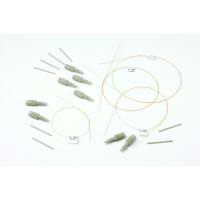Capillary Electrophoretic Determination of 4-Hydroxyproline
互联网
943
Capillary electrophoresis (CE) represents a relatively new separation technology that has gained acceptance in a wide variety of applications. A discussion of the basic theory of CE separations is beyond the scope of this presentation, but is well addressed in a number of recent texts (1 –5 ). In principle, differential migration of analytes in a potential field is achieved as a result of individual differences in mass/charge ratios. In CE, substantial advantage in separation speed, efficiency, and resolution is derived from the veryhigh field strengths (e.g., 150–300 V/cm) typically used. In addition, high field strengths induce the effect of electroosmosis in the column. The walls of the silica column have a negative charge and attract hydrated counter ions from the buffer. When power is applied to the system, the positively charged ions with their associated water molecules, migrate toward the cathode with substantial velocity. This results in the flow of water termed electroosmosis. The flow proceeds from the anode to the cathode and serves as a pump. Because the electroosmotic water flow is much greater than the velocity of the analytes, all components are swept to the cathode.








